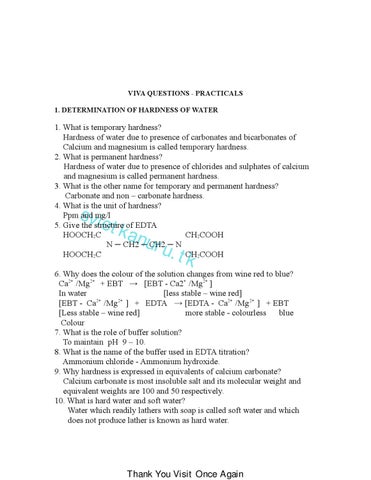VIVA QUESTIONS - PRACTICALS 1. DETERMINATION OF HARDNESS OF WATER
1. What is temporary hardness? Hardness of water due to presence of carbonates and bicarbonates of Calcium and magnesium is called temporary hardness. 2. What is permanent hardness? Hardness of water due to presence of chlorides and sulphates of calcium and magnesium is called permanent hardness. 3. What is the other name for temporary and permanent hardness? Carbonate and non – carbonate hardness. 4. What is the unit of hardness? Ppm and mg/l 5. Give the structure of EDTA HOOCH2C CH2COOH N ─ CH2 ─ CH2 ─ N HOOCH2C CH2COOH
svie
tka
nur
u.t
k
6. Why does the colour of the solution changes from wine red to blue? Ca2+ /Mg2+ + EBT → [EBT - Ca2+ /Mg2+ ] In water [less stable – wine red] 2+ 2+ [EBT - Ca /Mg ] + EDTA → [EDTA - Ca2+ /Mg2+ ] + EBT [Less stable – wine red] more stable - colourless blue Colour 7. What is the role of buffer solution? To maintain pH 9 – 10. 8. What is the name of the buffer used in EDTA titration? Ammonium chloride - Ammonium hydroxide. 9. Why hardness is expressed in equivalents of calcium carbonate? Calcium carbonate is most insoluble salt and its molecular weight and equivalent weights are 100 and 50 respectively. 10. What is hard water and soft water? Water which readily lathers with soap is called soft water and which does not produce lather is known as hard water.
Thank You Visit Once Again
